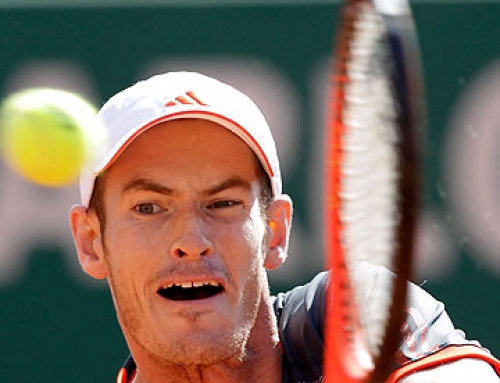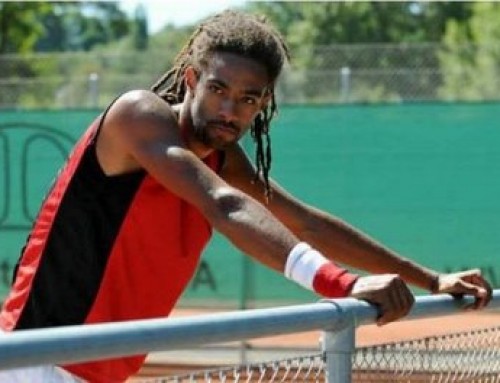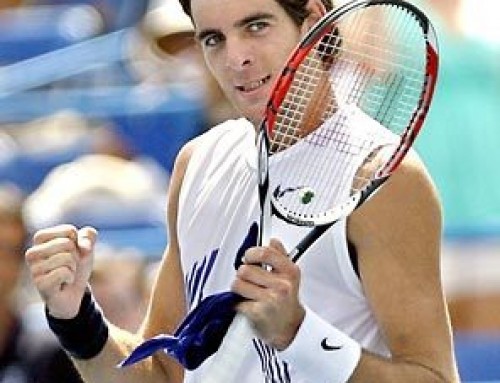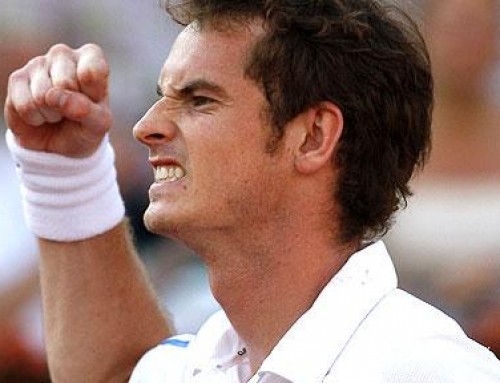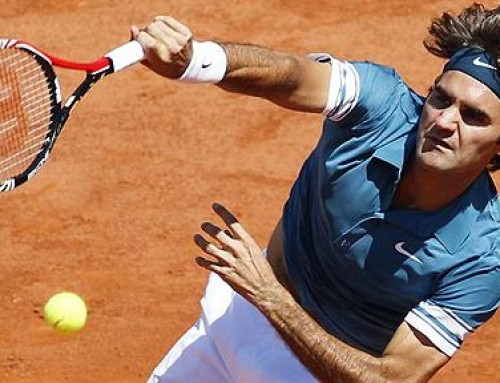Andre Agassi once said that before him, there were players that could hit hard, and players that could hit on the rise, but none that could do both. Clearly, his short-term memory forgot about Jimmy Connors, but we forgive you, Andre.
It was, however, Jimmy Connors’ rival, Bjorn Bjorg, then the father of modern power tennis, Ivan Lendl, that took tennis in a different direction. They pushed tennis away from the flat/slice stroke, approach the net at all cost that had dominated tennis for decades. Both the Americans and Australians played serve and volley, or at least, used the net frequently to end point.
Even a player as unique as Connors (a flat hitting baseliner, who was the precursor to the modern power game, but in an unusual sort of way) could not hit the ball so hard that he could simply camp on the baseline and expect to win. Connors looked for the short ball, and drove it deep, propelling himself to net where he would often finish the point with a two-handed backhand volley.
Borg and Lendl gave rise to a new idea in receiving serve. Give yourself space. It was not uncommon to see these players stand 10 feet behind the baseline. Conventional wisdom of the day was to stand near the baseline to receive serve, bunt the ball back if necessary. Indeed, one of the places this return strategy is still used frequently is doubles where standing ten feet back to return leaves the receiving team vulnerable to the poach. In doubles, players still crowd the baseline to return serve, even if the result is more aces, more unplayable returns, essentially making some doubles servers look like del Potro serving when the lack his monster pace.
Players like Lendl learned how to hit passing shots many feet behind the baseline. Without the modern power game, this strategy would be insane. A classic player would hit flat or slice, but the ball would either float too far or have almost no margin of error. The topspin style that grew to prominence in the 1980s, combined with the modern tennis racquet, allowed players who would otherwise never stand so far back, to employ a strategy that, on the face of it, seemed insane. How could someone give up so much space? And yet modern players hit so hard that even ten feet back, they hit balls chest height. The weekend player standing ten feet back would see the ball bounce several times before it reached them.
In the days of Rod Laver and Ken Rosewall, perhaps generations of people grew up without “proper” nutrition, and one aspect that was affected was height. As decades went by, people ate better, and the population of many countries grew, at least, on average. Laver and Rosewall were both diminutive men, maybe 5’7″ or so, and yet, both were champions. Such small men were commonplace in tennis. Players like Borg, Connors, and McEnroe were all under 6 ft tall. It was thought a player, much above 6 ft, would lose in mobility. Indeed, players like Victor Amaya, who was considered huge for his day at 6’5″ lumbered around, forced to serve and volley, because players his height couldn’t run.
However, as the 1990s rolled around, height became an increasing advantage. This was evidenced by taller players. Pete Sampras, Stefan Edberg, Boris Becker, Goran Ivanisevic, Richard Krajicek, and Ivan Lendl. All these players were now a shade above 6′ or more. Modern champs like Andy Roddick, Roger Federer, and Rafael Nadal were also a shade above 6′ tall. But the trend to height didn’t begin to fully manifest itself until the mid 2000.
Today, you have players like Juan Martin del Potro, Marin Cilic, Ivo Karlovic, Sam Querrey, John Isner, Tomas Berdych, Robin Soderling. Players at 6’4″ or higher starting to play top notch tennis from the baseline. Such players would be considered aberrations in the game 40 years ago. Tall men with huge forehands and the range to run down shots.
These tall players have built their games around huge serves and huge forehands. Andy Murray has found one way to play them. He uses his speed to play a defensive style many feet behind the baseline. His modern version of junkballing has propelled him to the top of the game, providing looks that today’s modern player finds it as infuriating to deal with as the average recreational player faced with a pusher.
However, Nikolay Davydenko may have found another solution. When the trend is to taller, bigger players that hit harder than ever, Davydenko has built a game suited more to his strengths, and when his game is on, it creates its own kind of problems. Davydenko has mastered four strokes as good as anyone in the game. He’s learned to hit the angled crosscourt forehand and backhand, and the down-the-line forehand and backhand. They seem like the bread-and-butter shots of tennis, but he’s pushed them to uncanny limits.
In particular, Davydenko’s angled shots can drive players mad. Players like Rafael Nadal, accustomed to standing 10 feet behind the baseline are driven so far off court that their only reasonable course of action is to hit a sharp crosscourt back. That’s important to note. Back when Ivan Lendl was king of the hill, he would often take the sharp angled shots of his day (which was not nearly as sharp as today) and hit the shot hard up-the-line. Hitting winners from the baseline was so novel that his opponents were often caught flat-footed watching the down-the-line shot go by them.
Today’s modern player would do what most players do if the down-the-line shot weren’t hit so hard. They’d punish you by hitting that ball back crosscourt. Because you had hit down the line, you were already off-court, leaving the rest of the court open. A down-the-line shot ought to be punished by a crosscourt reply. Today’s modern player understands this well. The modern players takes a wide angled shot and returns it back along that angle.
Ah, but this is where Davydenko uses his timing to advantage. While there’s been a trend by some players to trade space for time, that is, to stand further back to give more time, Davydenko looks to players like Agassi, Connors, and Federer. By standing closer to the baseline, he prevents angles from hurting him, and uses his precision groundstrokes to pick a direction to put his opponents in dire situations.
Here’s a sequence of play between Davydenko and del Potro that shows what Davydenko does. Davydenko had hit a widely angled backhand to del Potro’s backhand. This angle drove del Potro well wide of the left sideline, forcing him to hit a crosscourt shot back. Davydenko, standing near the baseline as he normally does, aimed a shot up the sidelines. Unlike Nadal or Federer, Davydenko always seems to give him self a comfort zone, placing the shot no closer than 3 feet from the sideline, but still close enough that del Potro had to run full bore to reach the shot. del Potro then did what common tennis wisdom tells you to do. He hits that down-the-line shot corsscourt.
But Davydenko had moved to his right, and hit yet another down-the-line shot back. By this point, del Potro had not yet recovered to the center of the court, and the down-the-line shot was a winner.
Davydenko has also mastered shots that make his style work. In particular, if you drive him hard crosscourt, he can still hit a sharp angle back to you. Nadal found this out the hard way. Without this ability, players could try to drive Davydenko off-court and a weak response would leave him vulnerable. It’s important for him to handle this kind of shot for his style of play.
Davydenko is essentially applying an axiom of tennis to his game. You can trade angle for power. It’s not that Davydenko can’t hit hard. Obviously all top players can hit hard. However, he doesn’t have the bludgeoning power that del Potro does. Where del Potro can see a neutral shot and see opportunities to hit a winner, Davydenko doesn’t usually manufacture winners out of nowhere.
Davydenko’s ability to hit four strokes (sharp angled forehand/backhand, down-the-line forehand/backhand) and to do so while hugging close to the baseline create problems for his opponents and provides a blueprint for today’s players. Indeed, because Davydenko has such a good backhand, he rarely has to give up the kind of court Federer does, who covers up his relatively weaker backhand by running around it. Indeed, Federer never seems to have the court open so much that he goes for the down-the-line backhand. The well-struck down-the-line backhand is one reason players like Djokovic and Davydenko fare so well at the top of the game. Davydenko used this shot to rob Federer of time in the semifinals.
Will Davydenko’s style of play, one that lead him to a victory in the ATP World Tour Finals be one that players who lack height, but have good speed will employ? Andy Murray’s game doesn’t lend itself to this style because he lacks the rock-solid consistency that Davydenko has. Also, Murray’s penchance for standing so far back is antithetical to Davydenko’s style. It was once thought that the way to beat Nadal was to overpower him like Federer or del Potro. However, Davydenko has shown that a steady diet of angles can also frustrate Nadal.
Now, to be fair, this style of play is primarily successful on faster surfaces where players are robbed of time. On clay courts, the time to run down shots encourages players to hit harder with heavier topspin. Davydenko still plays well on clay, but sometimes gets beaten by pace, say, by players like Soderling.
So while players like del Potro take the game in one direction, it’s possible that Davydenko’s style may provide a better long-term solution for more players.



